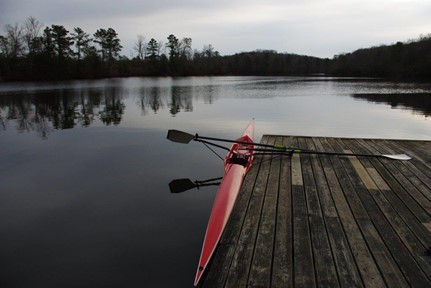 So we’re sitting in bed after the second day of “Rowing Camp,” an unlikely Mother-daughter/ spring break/50th birthday adventure, and as soon as I reach to turn out the lights for the night, my daughter, Bateman, begins her performance: “Ahhhh…there’s the core” she says, patting her hand on her abdomen and leaning back at a 45 degree angle in bed, “Where’s the core? There’s the core. There’s the core, (leaning forward and back), Where’s the core? Right there. (exaggerated now)….There it is… the core,” she says smiling. Given the fact that she’s only known him for two days, it’s a remarkably accurate impersonation of John Dunn. It matters not that he’s approaching 60 and she is not quite 14, her impr
So we’re sitting in bed after the second day of “Rowing Camp,” an unlikely Mother-daughter/ spring break/50th birthday adventure, and as soon as I reach to turn out the lights for the night, my daughter, Bateman, begins her performance: “Ahhhh…there’s the core” she says, patting her hand on her abdomen and leaning back at a 45 degree angle in bed, “Where’s the core? There’s the core. There’s the core, (leaning forward and back), Where’s the core? Right there. (exaggerated now)….There it is… the core,” she says smiling. Given the fact that she’s only known him for two days, it’s a remarkably accurate impersonation of John Dunn. It matters not that he’s approaching 60 and she is not quite 14, her impr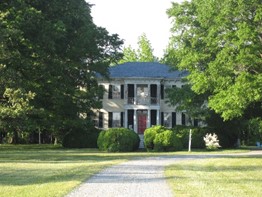 ession captures him perfectly. I had to make an effort not to laugh out loud for fear of waking up John Dunn or his wife Charlotte Hollings, both former collegiate coaches, competitive rowers, and now owners of Calm Waters Rowing, a facility committed to helping people become the best scullers they can be. Operated out of “Levelfields,”, a beautiful antebellum estate in Southern Virginia, from the façade, Calm Waters could pass for a beautiful B&B but from the inside, at this point at least, it is still a house of pain. And as I let my body fall back into bed being mindful not to use a single fiber of throbbing muscle tissue, Bateman, peeks out from under layers and layers of fresh, warm linens with a matelassé topping, and taunts me one last time, “Ahhh, there it is ….the core, yes, the core, ahhhh the core, OUCH the core.” If it didn’t hurt so much, I would have laughed myself to sleep.
ession captures him perfectly. I had to make an effort not to laugh out loud for fear of waking up John Dunn or his wife Charlotte Hollings, both former collegiate coaches, competitive rowers, and now owners of Calm Waters Rowing, a facility committed to helping people become the best scullers they can be. Operated out of “Levelfields,”, a beautiful antebellum estate in Southern Virginia, from the façade, Calm Waters could pass for a beautiful B&B but from the inside, at this point at least, it is still a house of pain. And as I let my body fall back into bed being mindful not to use a single fiber of throbbing muscle tissue, Bateman, peeks out from under layers and layers of fresh, warm linens with a matelassé topping, and taunts me one last time, “Ahhh, there it is ….the core, yes, the core, ahhhh the core, OUCH the core.” If it didn’t hurt so much, I would have laughed myself to sleep.
When I used to work for Joan Rivers, she would often remind me, (usually in the midst of making fun of someone else,) that “imitation was the highest form of flattery.” Bateman’s gentle teasing was simply an expression of what an impact John’s coaching had made on her in the first 48 hours. The things he said had stuck – – and in trying to balance the intricacies of learning a discipline that tapped into a refined sense of balance, strength and focus, his mantra of “Ahhh… There’s the core!” became our own. I have to tell you – – the way they taught felt revolutionary to Bateman and me. And the interesting thing was they said they didn’t always teach that way. When they were both coaching at Cornell, they taught from a different perspective altogether- – exemplifying classic form, and following the guidance of the ruling bodies of rowing for technique, strength and conditioning. But since they left collegiate rowing and went independent, John said they have had the luxury of time to really explore coaching in a different way. “We never had enough time in college coaching,” he explained. But over the past two decades in the middle of rural Virginia, John and Charlotte have all but perfected the art of deconstructing and reconstructing a winning stroke and teaching it to others.
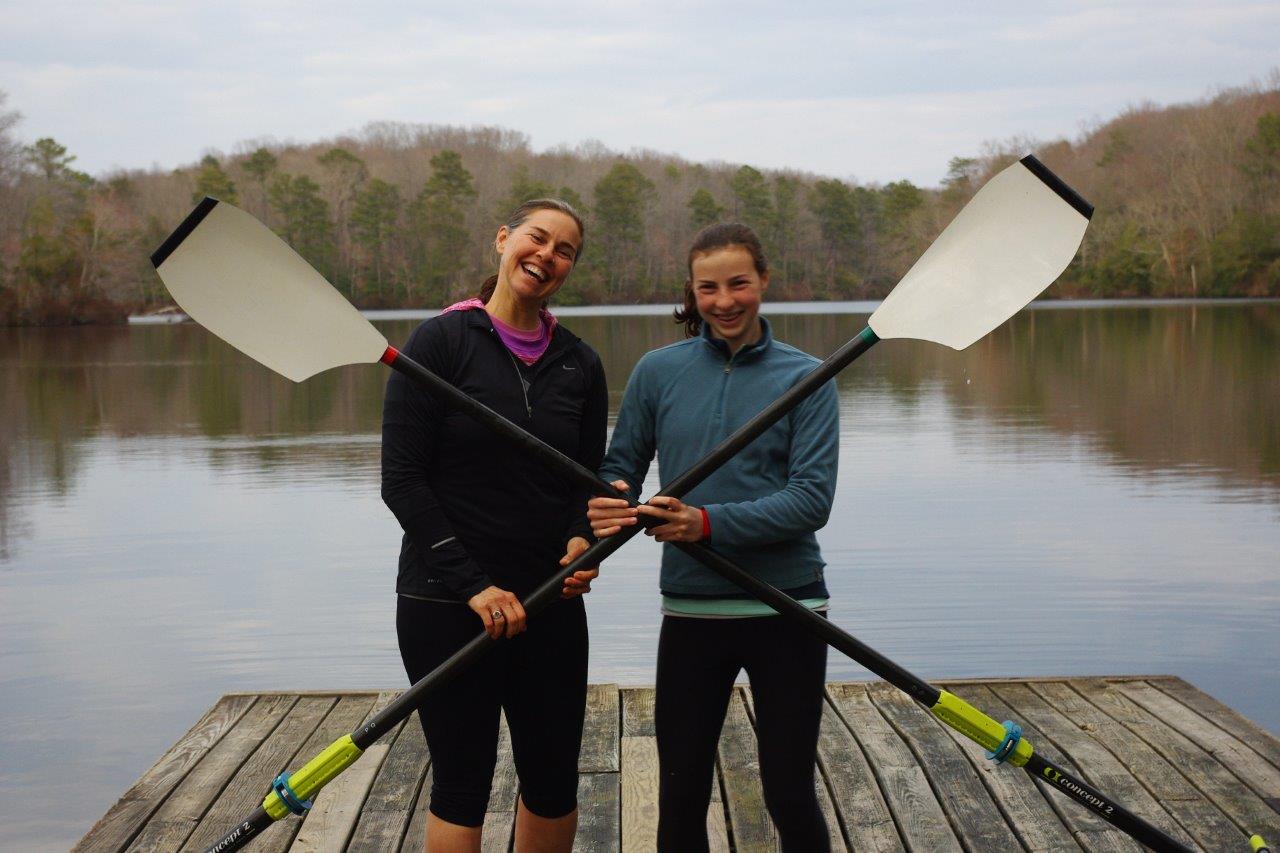 Our learn-to-row adventure was a four-day affair. I am no quitter, but by the end of the first full day I had blisters all over both hands and it hurt to stand-up, sit-down, lie-down and roll-over. There was no comfort zone within my own body. Bateman however was bounding about, exploring the house, playing with the cat and wanting to walk down the long, tree-lined lane. No.
Our learn-to-row adventure was a four-day affair. I am no quitter, but by the end of the first full day I had blisters all over both hands and it hurt to stand-up, sit-down, lie-down and roll-over. There was no comfort zone within my own body. Bateman however was bounding about, exploring the house, playing with the cat and wanting to walk down the long, tree-lined lane. No.
We started with zero on-the-water experience and by the end of our time at Calm Waters we could both navigate the mill pond in a 14 inch wide, rolling log of a racing scull – – one of us, without ever flipping out of the scull into the frigid March water a single time….never mind five. We saw hours of video showing elite rowers at the very top echelons of competition – – Olympic medalists and World Champions. The best of the best. We saw their technique progress from year to year. We watched how entire nations changed their form over time, to become more and more efficient and more and more competitive. We watched smaller, weaker rowers beat stronger , more able rowers, almost always based on technique. It was compelling. And then it was our turn. We would go out in the morning before breakfast and sp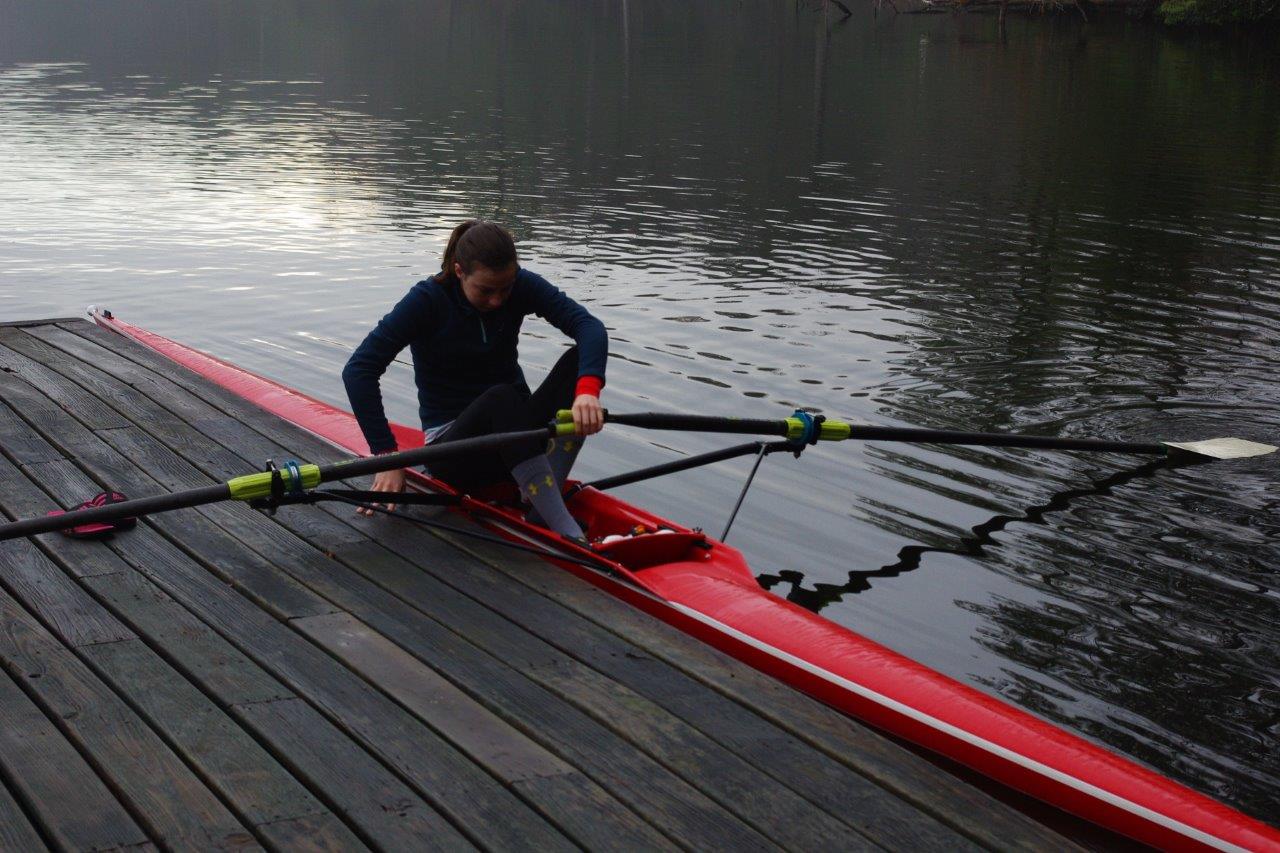 end about 90 minutes on the water practicing our stroke. In turns, Charlotte and John would follow us around in their skiff, video camera in-hand, shouting directions over the little outboard and taking footage from both the side and stern of the boat. After getting back to the house and enjoying a scrumptious breakfast, we would sit back down on the couch, close to the wood burning stove housed within the enormous living room hearth, and sip on hot cocoa and coffee while watching rowing videos – – both elite rowers competing in spine tingling races, and our slightly less impressive videos from the mill pond that morning. The process was painstaking but fascinating. Charlotte and John, would deconstruct the winning strokes, literally frame by frame. We were dealing with 32nds of a second. No kink or hiccup can hide from that kind of scrutiny. And none did. Hands not in synch, nesting too late, elbows too high, recoveries that began too soon or not soon enough, back too straight, body moving up not back, lats not engaged, every little error or inconsistency leaping off the screen as we watched race after race and then our own morning’s row. It was a deconstructed examination of both what to do and what not to do that served to literally reengineer our technique before we went back on the water later that day. It was a remarkable way to teach – – a few corrections at a time, until the stroke was refined and refined and refined and then practiced, practiced and practiced in three daily rows, day after day. Challenging, yes. Effective, absolutely.
end about 90 minutes on the water practicing our stroke. In turns, Charlotte and John would follow us around in their skiff, video camera in-hand, shouting directions over the little outboard and taking footage from both the side and stern of the boat. After getting back to the house and enjoying a scrumptious breakfast, we would sit back down on the couch, close to the wood burning stove housed within the enormous living room hearth, and sip on hot cocoa and coffee while watching rowing videos – – both elite rowers competing in spine tingling races, and our slightly less impressive videos from the mill pond that morning. The process was painstaking but fascinating. Charlotte and John, would deconstruct the winning strokes, literally frame by frame. We were dealing with 32nds of a second. No kink or hiccup can hide from that kind of scrutiny. And none did. Hands not in synch, nesting too late, elbows too high, recoveries that began too soon or not soon enough, back too straight, body moving up not back, lats not engaged, every little error or inconsistency leaping off the screen as we watched race after race and then our own morning’s row. It was a deconstructed examination of both what to do and what not to do that served to literally reengineer our technique before we went back on the water later that day. It was a remarkable way to teach – – a few corrections at a time, until the stroke was refined and refined and refined and then practiced, practiced and practiced in three daily rows, day after day. Challenging, yes. Effective, absolutely.
Charlotte had rowed in high school, then at powerhouse UVA, and went on to become an elite competitor on the US National Team earning both a Silver and then Gold Medal in the 1985 and 1994 World Championships – – accolades that book-ended a highly competitive career. After that she focused on coaching – – with great runs at Boston University, Stanford University and then finally Cornell, where she and John worked together to help The Big Red compete and win. John’s rowing resume is no less blingy. He picked up an oar for the first time his freshman year at Cornell and also went on to be a member of the US National Team earning a Silver and Bronze medal at the World Championships in 1975 and 1976. He then went on to be a successful coach at his alma mater coaching the women’s varsity 8 to a National and an IRA Championship during his years in upstate New 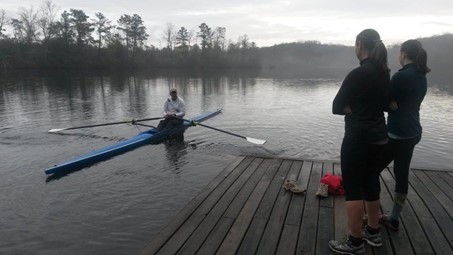 York. John and Charlotte came up with the plan to start “Calm Waters Rowing” together and have run the business out of “Levelfields” since 2001. They were delightful, earnest and really good at what they did. And when they hopped in their sculls they actually made them look stable as they instructed from the water, maneuvering themselves dockside as seamlessly as if they were mounted on a submerged and stable chassis. The whole time they instructed, their oars worked the water as delicately and lightly as an artist applying paint to a canvas. It is always a privilege to see someone who has achieved a certain level of expertise in a discipline make something very difficult, look effortless. John and Charlotte’s ease in their shells was a reflection of thousands and thousands of hours of practice. Think Yo-Yo Ma with a bow, Federer with a racquet – – that is Charlotte and John with an oar.
York. John and Charlotte came up with the plan to start “Calm Waters Rowing” together and have run the business out of “Levelfields” since 2001. They were delightful, earnest and really good at what they did. And when they hopped in their sculls they actually made them look stable as they instructed from the water, maneuvering themselves dockside as seamlessly as if they were mounted on a submerged and stable chassis. The whole time they instructed, their oars worked the water as delicately and lightly as an artist applying paint to a canvas. It is always a privilege to see someone who has achieved a certain level of expertise in a discipline make something very difficult, look effortless. John and Charlotte’s ease in their shells was a reflection of thousands and thousands of hours of practice. Think Yo-Yo Ma with a bow, Federer with a racquet – – that is Charlotte and John with an oar.
In the years since the pair stepped away from Collegiate Coaching, their philosophies about how to teach this discipline have changed. And what was really interesting to me was how it took time away from the daily grind – – it took distance and perspective – – for them to really pause long enough to ask the ultimate question: What wins? What is it, when applied to any rower, that enables them to be the fastest they can be – – and ultimately faster than anyone else? And what they came up with wasn’t size or strength or even the varying degrees of athleticism or training that created hierarchy amongst even the most elite athletes. It was technique – – that was the answer. That was what made the difference. It was the manner in which they executed the stroke. Technique has long been a matter of heated debate. And over the years in this venerable sport, technique has varied and swung like a pendulum. Presently, US Rowing distributes posters to schools and programs across the country that demonstrate “proper” technique that is rigid and upright. The very competitors, in fact, who posed for those how-to photos cross their own winning finish lines with markedly different form that the one they advertise. And a long time ago, John began to note the discrepancy between what was taught as proper form and what got competitors over the finish line first. The athletes who were winning the major titles, didn’t look like that poster. They 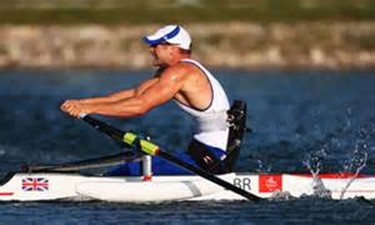 were pulling in a totally natural, relaxed “C” form, their backs curved toward the bows of their boats, the physics of it all forming a horizontal explosion of power connecting the oars to relaxed, bent arms, and ultimately the power of the rowers’ lats. John, with the mind and training of an engineer, was all about the physics. Charlotte, at heart a true competitor, teaches more visually and out of a place of “feel.” Totally different, but beautifully woven approaches to the same idea that there is one perfect way to move a boat across the water and it has everything to do with winning technique. They are fighting an uphill battle against the rowing establishment, but their fight has merit, and together, John and Charlotte are a compelling and elegant argument for change.
were pulling in a totally natural, relaxed “C” form, their backs curved toward the bows of their boats, the physics of it all forming a horizontal explosion of power connecting the oars to relaxed, bent arms, and ultimately the power of the rowers’ lats. John, with the mind and training of an engineer, was all about the physics. Charlotte, at heart a true competitor, teaches more visually and out of a place of “feel.” Totally different, but beautifully woven approaches to the same idea that there is one perfect way to move a boat across the water and it has everything to do with winning technique. They are fighting an uphill battle against the rowing establishment, but their fight has merit, and together, John and Charlotte are a compelling and elegant argument for change.
If you know me, you know I eventually wind up getting to God – – but what on earth does this have to do with God? Everything. And it’s such a great parallel. Bear with me. It should no longer surprise me that entities can falsely advertise what works….even with the best of intentions. Take those rowing posters…they make it seem like the more military precision and rigidity you bring to the stroke, the stronger and faster you will become. Not true. And then take Christians. Looking from the outside, in, Christians make it seem like it’s all about being “good.” And it’s almost the complete opposite – -it’s that we know we can’t get it right, and that we need God in us to reflect goodness. We know that it’s not us; it’s the love Jesus showed us by sacrificing himself for us on the cross; and the Holy Spirit’s presence in us that frees us to have an abundant (if not ungraceful) life.
Before I was a Christian, everything I could decipher about Christians looking from the outside-in never really drew me to them, and I have never forgotten that. But what I learned from that too was that if God wants you He’s going to get you no matter what your experience or lack of experience with Christians or religion has been in the past. That being said, it would still be wonderful if God had an army of Christians who were so loving and transparent that they were like magnets that drew people to Him. Many times, we Christians can be terrible ambassadors of our faith. We can be like those posters showcasing polar-opposite form to what actually works.
I know now, looking from the inside of a life of faith outwardly, that there is such beauty in the body of Christ – -that there is such vulnerability and grace in those who believe and seek to live a life submitted to Christ. I see a wonderful, broken people who share a common language of love and know their best efforts will fail somewhere along the line and they will have to depend upon God. It is a sisterhood like none other. I wish we reflected that to the world more. It is Christ in us that is beautiful, and too often the world just sees us.
Someone once told me a Christian life is never lived at 100 miles an hour. So true. A Christian life is lived at the pace John and Charlotte live in Levelfields. It’s lived slowly. Thoughtfully. Thoroughly. Intentionally. It is lived not checking off boxes, but rather pondering what will make a difference and doing that – – seeking to find what actually works. God’s way works. But it’s not often the most efficient way from point A to point B – – which is generally the path I try first. Honestly, I am ALL ABOUT efficiency. I think a lot of Mom’s are. But I also think I have gotten confused about the point of life. I think when I became a Christian I thought the point was getting where God wanted me to go. So I made up those destinations or boxes along the way and then tried to reach them or check them off – – like way-points on a scavenger hunt. I studied, I worked, I read. I prayed, I pondered. Check Check Check. God was an idea to be mastered, a character to be understood. His path for me was a route I felt I was supposed to figure out. But it’s not about getting to the next clue. It’s not. And it’s not about finishing first or best. It’s about HOW I travel from one point to the next. It’s about HOW I conduct myself along the journey. It really actually is. The checkpoints, the destination (if there is one) is not my job to determine or dwell upon. It’s the journey. It’s not getting the kids out the door for school in time – – it’s is about how loving and gentle and caring I was to them during that time between waking them up and sending them off for their day.
In trying to “get there,” I have been chasing the wrong goal for many years and it’s a hard habit to break. But what joy to be discovering the actual task at hand. It certainly changes a lot – – my focus, my speed, my “Living- technique” itself. In rowing and in life the perfect technique is an absolute truth. Neither one can be executed perfectly all the time, but the perfect technique exists – – it’s there. In rowing it’s all about physics and the laws of motion working themselves out from a body through an oar to the water. “THE” way is the way that generates the most power, creates the least drag and propels you over the finish line having optimized the effort exerted. Everybody, at every stage of conditioning can have a perfect stroke. And if I take that perfect stroke – – it will propel me further and faster in the water than any other stroke I can take. In life, the perfect technique is God’s way, not my own. But it’s actually God in me, not me acting like God – – a distinction that sounds subtle, but is the furthest thing from it. Take Charlotte and John, for example. For years, they looked to replicate “Classic Form” in their rowers, instead of doing what they are doing now, coaching the winning form of the world’s top competitors. Each one of the rowers that comes through “Calm Waters” has a perfect stroke in them – – a stroke that given their design and build will hit that sweet spot of power and efficiency, driving them further and faster than any other stroke. In the same way all believers have the perfection of God already in them. But instead of accessing God in me, I often SO OFTEN, try and simply “act like God” or “do what God says” – – and my finest efforts at replicating a perfect God will at best look like a well-intentioned rowing poster advertising poor form.
I need to take a step back like Charlotte and John did with coaching technique and reconsider the way I want to approach my entire relationship with God and how I choose to live a life of faith. As a believer, I don’t “activate” the Holy Spirit in me, He is already there. I have been trying to imitate Christ (WWJD, Right?) rather than just let his Holy Spirit shine through me. I was trying to be “like God”, rather than letting God be God, through me. I was trying to do it. And I can try for the rest of my life but my efforts are not needed or effective – – it is my yielding to His Spirit in me that is necessary and powerful. Those are two completely separate and unrelated things. And I have been banging on the door of Holy imitation for a long time, instead of opening the door to simply abiding in Him.
I am an imposter when I try and “be like Christ.” I am not like Christ. But Christ is in me, he is able, he is willing and he loves me. The only way to have God shine through me is for me to build relationship with Him and let Him come out and do his supernatural thing. How do I yield? I quit trying to yield and start focusing on spending time with God. That’s not the type A answer, but it’s the one that works. I have battled with my own efforts for years and have neglected time shared with God – – agenda free – – reading, praying, meditating, chatting. Those are the things that create the opportunity for God to live through me in life.
The last thing I will say is this – – and it was one of the most striking revelations during my time at Levelfields – – Elite athletes have impossibly high VO2 max’s. In a great athlete, VO2 max is the capacity a set of lungs has to keep exerting effort long after “normal” lungs give out. Some of the smaller athletes who have nothing physically on their larger, stronger counterparts can still beat them if they have a more efficient capacity to process oxygen. John showed us one Olympic trial in which a tiny woman, literally half the size of her competitors, but with an enormous and documented VO2 max, beat the entire field in a stunning display of what efficient oxygen use can do. She just could keep going at a pace at which the other competitors’ lungs simply stopped delivering the volume of oxygen to their blood necessary to fuel their muscles to row faster than their diminutive competitor. Simply amazing to watch. Well if I think about it in those terms, Jesus is the VO2 max King. His capacity for perfection, love, kindness, gentleness and sacrifice are so far beyond my own ability to deliver the same, but he lends his VO2 to me in the form of his Holy Spirt. He puts that capacity in me – – I have in me superhuman, supernatural capacity to deal with life. I have God’s capacity in me. I can DRAW on that perfect power at any time. So why would I ever depend upon, or trust my own capacity over His? What a concept.
Isn’t it funny (and funny, tragic, not funny ha-ha) that I try and try and try in my own power to get it right, but it is only when I let go completely and give the reigns to God that I am able find that perfect sweet spot of “meekness” in relation to God. And “meekness” – – perhaps one of the most misunderstood words in Christendom, means Power under control. It’s my life, willingly placed under God’s control, not my own. So meekness isn’t wussiness – – quite the contrary – – meekness is the smartest, most efficient way to experience the power of God. So what did I learn from Charlotte and John? So many things. First and foremost that my daughter is a much better rower than I will ever be, and secondly that here are two remarkably talented coaches and communicators out there who in a stroke of genius, decided to start coaching winning technique rather than classic form. That’s their gospel…. and they’ve got the right idea. So what’s the perfect technique for living my life? It’s living yielded to the Spirit of God in me. God’s way is the perfect stroke, every time. And God works through me best, when I spend time with Him. That’s my formula – – that’s my technique. That simple. Lord make me meek unto you.
All Photos of Calm Waters and Levelfields were taken by RoseAnna Schick who rowed with us during our time at Calm Waters and whose travel writing can be found at www.ras-words.com . Not only did fellow “camper” RoseAnna have the world’s best attitude about everything, she is a brave soul, who literally breaks through ice to row in Canada! Future blog, no doubt named, “Indomitable Spirit”, coming soon….

Wow, that is some blog Karen! Stephanie shared the link with me. I think you give us too much credit but thank you. It was an incredibly fun week and I’m glad that it meant something to you spiritually as well as physically. Hope you can find a way to continue! All the best, Charlotte